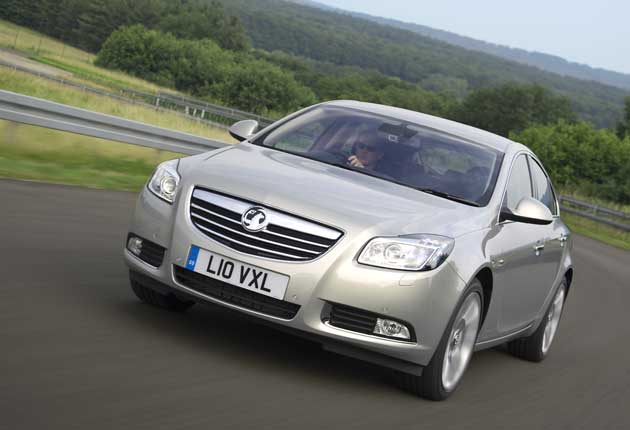Vauxhall GM Insignia
GM's got gizmos you never knew you needed

The Vauxhall Vectra is dead, killed by worrisome associations with mediocrity and dullness. In its place comes a new car with a new name: Insignia. It's a slightly cheesy name, too close for comfort to the doomed Consignia branding that tried to make the Royal Mail something it isn't, but it's attached to a promising-looking car.
General Motors Europe hopes the Insignia might be spoken of in at least part of the same breath as an Audi or a BMW. The new car's launch, biased in presentation towards the German Opel branding rather than British Vauxhall, talked of "sculptural artistry with German precision", but the UK marketing won't go there. The Insignia's premium-level aspirations will do it no harm, though.
Are they justified? The body styling, masterminded by British designer Mark Adams, is smooth in profile but crisp in detail, with a dramatic scooping-out of the flanks and a near-fastback tail. This crisp curviness continues inside, with various aluminium-look highlights continuing the shape of that flank sculpting. But some of the surfaces aren't quite "premium", being too hard and shiny, and a fairly basic version I tried had a horrid, clunky handbrake and poor trim fit. Others were better (and had electric parking brakes): perhaps we can put it down to the rogue car's early build.
GM is very proud of the Insignia's technological gizmology. The most obvious is the option of the "Opel eye" or, here, "Vauxhall eye". It scans the road ahead and if it sees a speed-limit sign, a no-overtaking sign or a sign denoting the end of either type of zone, it reproduces that sign on a display between the two main dials. Clever, yes?
As a bit of electronic showing-off, perhaps. But is it useful to be nannied in this way? We humans each have two eyes entirely capable of reading the signs and we don't need a car to do it for us, especially at the cost of a hefty, intrusive lump of plastic cowling stuck below the interior mirror. This is one of those "things you didn't know you needed" inventions. The same goes for the audible warning that you have strayed from your lane, as used by other car makers. If you're wandering that much, you shouldn't be driving.
Better by far is the adaptive forward lighting system, which gives up to nine variations of headlight beam depending on speed, weather, terrain and proximity to other traffic. And you can make mirror-images of the beam patterns via the car's computer menu for when you drive in foreign lands.
Then there's the FlexRide system, which lets you choose between tour, standard and sport for the way the Insignia steers, reacts to bumps, points through corners and responds to the accelerator. The instrument graphics even change from white to red in sport mode, no doubt to reflect your new mood. Also, you can tailor each mode to your liking if, for example, you prefer a softer accelerator response to go with your crisp steering. If you choose one of the two turbo petrol engines, a 2.0-litre four-cylinder with 220bhp or a 260bhp, 2.8-litre V6, you can have "adaptive 4x4" which varies the drive between front and rear axles.
It works well, making the Insignia interact better with the driver than any Vectra did but, perversely, I enjoyed the front-wheel-drive version of the 2.0 turbo the most for its lighter-footed feel. This engine, smooth and responsive, renders the thirsty V6 all but redundant, and it's this Insignia rather than the slightly grumbly, 2.0-litre diesels (in three power options all with the same 154g/km CO2 rating) that makes the best job of trumping Ford's equivalent Mondeo. There's also a non-turbo 1.8-litre petrol engine.
The Insignia is a good-looking, well-specified car that's pleasing if not exactly inspirational to drive, but rear passengers will not be pleased if the front seats have optional electric adjustment because they'll have nowhere to put their feet. That's one detail the designers missed.
The Rivals
Citroën C5 2.2 HDI: from £19,895
There's a German influence in this otherwise very French car. Comfortable and effortlessly rapid with this 175bhp, twin-turbo diesel engine.
Ford Mondeo 2.5T: from £21,645
Hardly a popular choice, given the five-cylinder, 220bhp petrol turbo's relative thirst, but it's the most enjoyable car to drive.
Renault Laguna 2.0T: from £18,740
The engine is well known in Méganes; here it's in 170bhp form and matched only to automatic transmission. Dull outside, rather pleasant inside.
Join our commenting forum
Join thought-provoking conversations, follow other Independent readers and see their replies
Comments
Bookmark popover
Removed from bookmarks